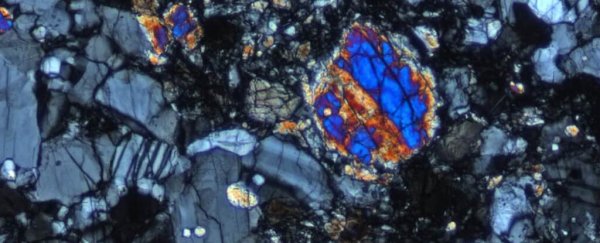Scientists have re-analysed fragments of a Moon rock brought back in 1972, and say that its composition reveals our planet's satellite really doesn't have water inside.
Figuring out the wetness of our Moon is highly important not just for future lunar missions, but also for better understanding of its composition and origins. And these new results appear to contradict a recent study that claimed the Moon has loads of water. So, what's going on?
A team led by geochemist James Day from the University of California San Diego has run a fresh analysis on one of the most volatile-rich Moon samples we have, a chunk of rock collected by astronauts of the Apollo 16 mission.
Known as 66095 or "Rusty Rock", this sample was collected from the rim of a crater at the base of Stone Mountain, just south of the mission's landing site.
"Let me whack this thing right here," said lunar module pilot Charles Duke, chipping off a piece of boulder that ended up being a baffling sample for geochemists studying the Moon's cataclysmic history.
 Collection site of 66095 (bottom left) and the boulder (centre). Credit: NASA
Collection site of 66095 (bottom left) and the boulder (centre). Credit: NASA
Volatiles - elements with lower boiling points that readily vaporise with heat - provide important clues for understanding how the Moon formed.
"It's been a big question whether the moon is wet or dry. It might seem like a trivial thing, but this is actually quite important," says Day.
"If the moon is dry - like we've thought for about the last 45 years, since the Apollo missions - it would be consistent with the formation of the Moon in some sort of cataclysmic impact event that formed it."
What Day is referring to is the well-established idea that a chunk of Earth got violently knocked out of our planet by a giant asteroid in its very early days, going on to form the lumpy round object we see in our skies.
That piece torn off the young Earth and the asteroid would have formed an extremely hot, boiling ball of magma, which would cause the most volatile elements such as chlorine, zinc, potassium - and also water - to rapidly boil off and deplete.
But samples of the Moon have revealed a contradictory picture - some are really 'dry', supporting this idea of rapid volatile depletion. Others, like Rusty, have turned out to have plenty of volatiles.
"The origin of these volatiles, however, remains enigmatic," the team writes in the study.
The team's analysis has now revealed that Rusty actually contains lighter isotopes of zinc, which makes it consistent with this element evaporating and condensing during the Moon's early boiling magma phase.
 Close-up of the 'rusty' metallic salts on the surface of the sample. Credit: NASA
Close-up of the 'rusty' metallic salts on the surface of the sample. Credit: NASA
That, in turn, makes this sample consistent with something you'd expect to emerge from the interiors of a bone dry - not wet at all - Moon.
"I think the Rusty Rock was seen for a long time as kind of this weird curiosity, but in reality, it's telling us something very important about the interior of the moon," says Day.
So far, so good. But you may recall hearing just a couple months ago that the Moon actually has a lot more water than we thought.
In July this year, a study published in Nature Geoscience revealed rich deposits of water locked inside tiny beads of volcanic origin, all over the Moon's surface.
"The nearly ubiquitous presence of water in large and small lunar pyroclastic deposits adds to the growing evidence that the lunar mantle is an important reservoir of water," the researchers stated.
And that could still be true, depending on how the water is locked up. The new findings about Rusty don't entirely contradict the findings of those volcanic deposits, which were made with extensive satellite data.
What's tricky here is that we still don't know where all that water in the volcanic beads came from.
"Their study says that all of the glass bead deposits on the lunar surface are 'wet,' which is a great observation," says Day.
"However, they cannot elucidate the mechanism of their formation."
One idea is that the locked-up water would have been spewed out by volcanoes from the hot interior of the Moon, although it's also possible that the water actually got delivered there through impact with other cosmic objects.
The new study featuring Rusty also looked at some volcanic beads, and the team says if the water got there through condensation (just like the zinc isotopes in the rock sample), that would still be consistent with the idea that our Moon is crusty dry on the inside.
There's more work to be done, and Day's team will continue to chip away at this problem.
"That's where we're going next," he says. "It seems like the logical next step to try and solve this problem."
The study was published in PNAS.
